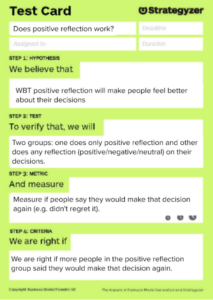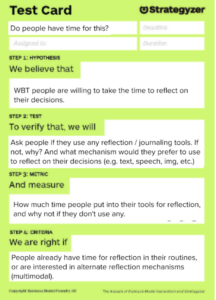Team 3: Alahji Barry, Elyse Cornwall, Kaitlin Peng, Anooshree Sengupta, Cecilia Wu
Experiment 1
Overview
In this experiment, we wanted to understand the impact of positive reflection and test our assumption that it would make our target users feel more comfortable with and confident in their decisions. Although the original test card mentions comparing positive reflection with any sort of reflection, we decided to instead delve deeper into the impacts of positive reflection alone.
Our feedback suggested using a Likert scale to evaluate how users felt about their decision before and after reflection; we decided to ask them to rate their confidence about a decision on a scale of 1-10. Rather than ask for broad positive reflection, we decided to instead prompt users by asking both how they felt about the decision and to name three positive impacts of the decision.
Participants
We recruited 5 target users—two in college and two who had just graduated—one of whom had also participated in our intervention study. Because the survey is relatively short, we distributed the form over text and GroupMe over a few days, letting participants know that the decision they chose to analyze in the survey did not need to be consequential. This attracted more participants as we purposefully framed the task as easy and potentially helpful, which is also how we will likely frame reflection in our final product.
Artifacts
Participants filled out this Google Form. The form asked the following questions:
- Name a decision that you made earlier today or this week.
- On a scale of 1-10, how confident do you feel about this decision?
- How did making this decision make you feel?
- Name three positive outcomes of this decision.
- After reflection on your decision, do you want to change the number you provided in Question 2?
- IF YES, what value would you now provide?
- IF YES, how does it differ from the value prior to reflection?
We intentionally made the survey as easy to fill out as possible because we do not anticipate making positive reflection in our final product a terribly long or overly-intentional process; we want it to be straightforward!
Final Synthesis
In addition to the learning card below, a few interesting insights surfaced from the survey:
- A majority of participants (60%) updated their confidence score following reflection.
- A majority of participants (67%) who changed their confidence score increased it.
- One participant did, however, mention that “I struggled to come up with 3 positive outcomes, making me think it perhaps wasn’t the best choice, “ suggesting that we should modify the reflection prompt

Experiment 2
Overview
Our original test card said that we would ask participants about their current reflection habits to determine if people have time for reflection. We did this by conducting short in-person interviews with a mix of participants from our intervention study and some new participants. All were college students given our focus on helping people who make frequent, important decisions. Link to our assumption mapping
Some of our feedback also suggested that we make this test more like a study; rather than asking participants if they reflect, we could ask participants to write a reflection each day to test if this was a feasible task. This reminded us of our intervention study, in which participants reflected on their top priorities throughout the day. We wanted to draw from this existing data, and ask these participants how their experience with short daily reflections went in this intervention study. We combined this data with the results of our interviews to reach our final conclusions.
Participants
We recruited 4 participants for our experiment, two of whom had participated in our intervention study, and the other two were new users. We aimed to gain insights into the feasibility and sustainability of short daily reflections by asking the two past users about their experience with the daily reflection component of our intervention study, specifically to assess if they had time to reflect. In contrast, we wanted to obtain perspectives from individuals with no previous knowledge of our study, which is why we recruited the other two participants. By enrolling a diverse group of participants, we were able to gather valuable insights into the practicality of daily reflections and the usefulness of reflection tools.
Artifacts
We interviewed participants in-person, following a brief set of questions and then inputting our notes into a Google form. Participants did not fill out this questionnaire themselves – we just used this medium to consolidate our answers. Here’s our questionnaire:
Do you currently use any reflection tools (e.g. journaling, apps, etc)?
- If YES (choose a specific tool):
- What tool?
- Why do you use it / what do you reflect on?
- How much time do you spend using this reflection tool?
- How often do you use this tool?
- If NO:
- Why not?
Final Synthesis
We had two participants who didn’t use reflection tools, and both of them said that reflecting seemed too time-consuming and they felt “lazy” for not wanting to do it. The other two participants reported that they did use reflection tools, one by writing in their notes app several times a week, and the other by journaling for half an hour every month or so. Even though these participants seemed to have conflicting experiences with reflection, we quickly realized an overarching theme: people need flexibility and want to reflect on their own time.






Comments
Comments are closed.